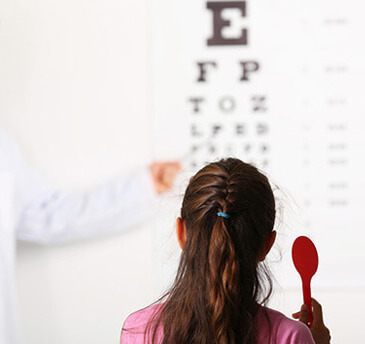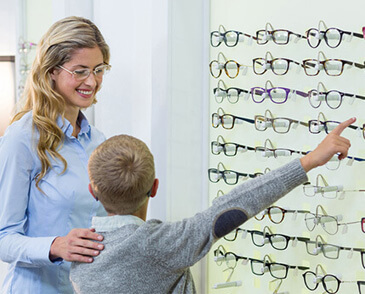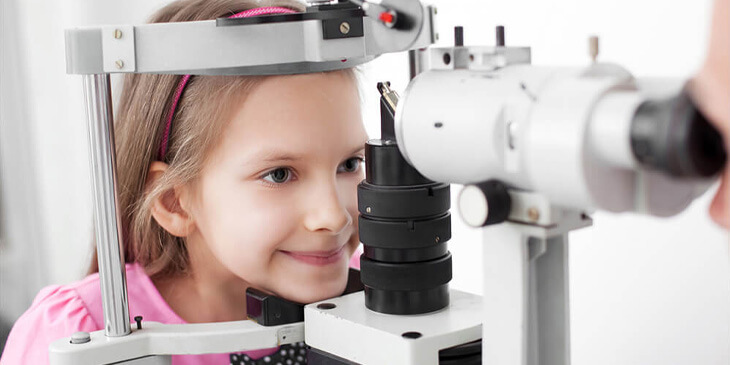Every child’s development requires proper pediatric vision care, and there are unique factors to take into account. For your child to be healthy, their eyes and vision must develop properly. Every year, your child needs to undergo an eye exam. Regular eye exams can aid in the early identification of eye conditions and vision issues.
How Can You Tell If Your Child Has Eye Issues?
Your child may exhibit behavioral and physiological symptoms that point to a vision issue. Keep an eye out for these signs of vision impairment in your child:
- Constant eye rubbing
- Extreme light sensitivity
- Poor focusing
- Poor visual tracking (following an object)
- Abnormal alignment or movement of the eyes (after 6 months of age)
- Chronic redness of the eyes
- Chronic tearing of the eyes
- A white pupil instead of black
- Crossed eyes

If your child is currently in school, they may already be exhibiting some of the following symptoms:
- Inability to see objects at a distance
- Inability to read the blackboard
- Squinting
- Difficulty reading
- Sitting too close to the TV
When Should A Kid’s Vision Be Tested?
Every year, or more frequently if particular issues or risk factors are present, or as advised by your eye doctor, your child should get an eye checkup. Unfortunately, if a child passes a school screening, parents and teachers sometimes believe wrongly that they do not have a visual problem. However, a lot of school vision exams simply evaluate far-field visual acuity. Even if a youngster has 20/20 vision, they may still have vision issues. In fact, successful reading and learning require much more sophisticated vision abilities.
A comprehensive optometric examination should be given to a child even if they pass a kid’s vision test if:
- They exhibit any of the aforementioned warning signs or symptoms of a vision issue.
- They aren’t performing to their full capacity.
- Although they can only accomplish a small amount, it takes them a lot of time and effort.

There are times when your child’s vision changes without your knowledge. As a result, your child should have an eye exam once a year, or more regularly if there are particular issues or risk factors, or if your eye doctor so recommends. The sooner a visual issue is identified and addressed, the higher the likelihood of a favorable outcome.
Testing Your Childs Vision and Eye Health
Did you know that 25% of students and 5% to 10% of preschoolers have untreated visual issues? Every year, have your child get an eye checkup to ensure an early diagnosis of vision issues and eye disorders. Children benefit greatly from early intervention. Children starting kindergarten or enrolling for the first time in a public, private, or parochial primary school in the states of Missouri and Illinois are required to have a full eye exam conducted by an Optometrist or Ophthalmologist.
Examining your family and medical history, testing your vision and eye alignment, and assessing your eye health are all common components of eye exams. Depending on the child’s age, different examination procedures are used. The test is similar to an adult in terms of difficulty for kids who can read, they are instructed to read the letters on the Snellen eye chart that is ten feet away while covering one eye.
Your eye doctor might use a chart of LEA symbols rather than letters for kids who can’t read yet. An apple, square, circle, and home are a few of these symbols. Using 3-D glasses and unique dot patterns, a random dot stereopsis test can be used to assess how effectively your child’s eyes are working together. Your eye doctor may perform a retinoscopy test, in which she/he shines a light into the eye to look at the reflection from the retina, to decide your child’s eyeglass prescription.
Infants by the age of six months should be able to see color, depth, and focus just as well as an adult. Your doctor may use a light to test the eyes’ ability to respond to the light in order to assess the health of your infant’s eyes. The fixate and follow test shows whether your infant can track a moving item. Infants may fixate on and follow an object as early as three months old. Striped cards may also be used by your eye doctor during a preferential gazing test to draw a baby’s attention and evaluate their eyesight.
If you are looking for a Pediatric Eye Care Specialist in the Paducah, KY area, give our team at Brush Optical a call today. We are here to make sure that your child has the proper eye care!






